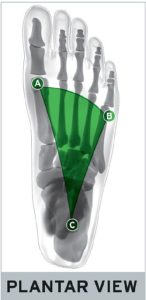Plantarfasciitis is the most common foot related complaint we see in our clinics.
Before we dive in and review common causes of plantarfasciitis, let’s take some time to review a bit of anatomy of the foot, to better understand why symptoms occur. We have three arches in our foot, all of which need to be functioning properly in order to support pain free motion. In this image provided by foot levelers, you can see a great illustration on where these three arches are within the bottom, or plantar surface of the foot:

These arches act as a cantelever, or vault. When they are strong and working appropriately, the arches are able to tent the foot and prevent crucial components of the plantar surface of the foot from contacting the ground.
As the arch continues to drop more and more, we can start to experience the following symptoms:
- Heel pain
- Calf cramping/soreness
- Burning sensation in the arches of the foot
- Aching sensations in your ankle and foot
- Low back pain
- Knee pain
- And much more!…
Here are some common causes of plantarfasciitis:
- Fallen arches in the foot
- Overuse, or exercise induced trauma
- Traumatic injury to the foot
By far, one of the most common causes of plantarfasciitis we see is related to fallen arches in the foot. There is a high correlation between poor mechanics of the foot and ankle, which often result in plantarfasciitis. As you now know, we have three arches in our feet, and when any of those muscle groups are not working appropriately, we frequently see poor mechanics that will eventually lead to a painful response.
Additional reasons that plantarfascitiis presents is due to overuse or exercise induced trauma. While exercise is a great means to improve or stave off many ailments, sometimes too much is too much. In these cases, we frequently see a coupled concern of improper shoe wear. Check those treads frequently, and be sure that you have a good support for your type of shoes. (We’ll cover proper shoe wear in a subsequent post! Stay tuned!)
Finally, traumatic injury to the foot is another causative factor. Strained tissue, weakened tissue and even overactivity as a result of trauma could be the primary concern if you develop plantarfascial pain.
Want more content like these delivered to your inbox?
